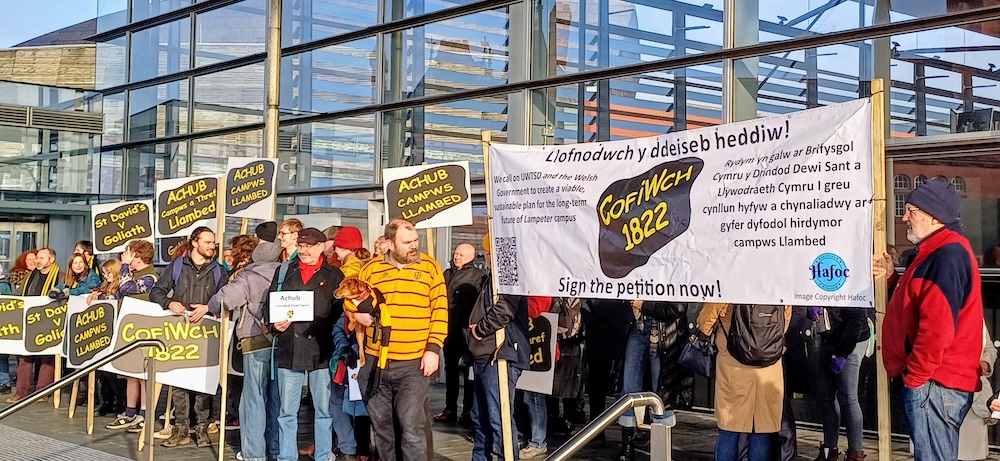John Osmond on why unanswered questions around a killing 27 years ago continue to grip our attention
Why does the grotesque murder of a 78-year-old spinster, a rose grower, in Shrewsbury 27 long years ago still retain the power to capture our attention?
There are many layers to unravel in answering this question. The first lies in the character and campaign of the extraordinary woman at the centre of what became the melodrama, Hilda Murrell. She was among the first women to graduate from Cambridge, obtaining her degree in 1927, after which she returned home to Shrewsbury, eventually to take over the family horticultural business. In her later years she became much exercised by the dangers of the nuclear industry. At the time of her violent death she was about to give detailed evidence to the inquiry into the proposed Sizewell B nuclear reactor in East Anglia.
Hilda had two major concerns with nuclear power. First, the by-product of its generation is plutonium, a highly hazardous material which will create radioactive fallout should there be a breach in safety. Secondly, this nuclear waste needs to be stored for hundreds if not thousands of years in a secure environment – typically below ground – before its radioactivity diminishes to safe levels. The continuing relevance, indeed urgency, of Hilda’s concerns was demonstrated in March this year when catastrophe struck Japan following the earthquake and tsunami that eviscerated the nuclear power plants at Fukushima. Two thousand square kilometres of land were contaminated. Radioactive caesium from the disaster is still circulating in the currents of the Pacific Ocean and will return to the shores of Japan in 20 or 30 years time.
Will Fukushima be allowed to fade in the memory just as have the Three Mile Island nuclear reactor meltdown in Pennsylvania in 1979, and the Chernobyl disaster in the Ukraine in 1986? Not if the memory of Hilda Murrell has anything to do with it.
A second layer in the story surrounding Hilda’s death was the military and political events that became closely associated with the event. In December 1984 the Labour MP Tam Dalyell got up during an all-night sitting of the House of Commons and announced that “men of British Intelligence” had been involved in her murder nine months before. How could this be?
The link, or coincidence, was the fact that Hilda’s nephew, Commander Robert Green had been part of the naval intelligence operation at Northwood, London, at the time of the Falklands War in May 1982. He was one of only 20 or so people who knew the detailed circumstances around the sinking of the Argentine cruiser General Belgrano. It was torpedoed by the British nuclear submarine HMS Conqueror on 2 May 1982, with the loss of 321 Argentine lives.
In the months that followed Tam Dalyell pursued the truth behind the sinking with dogged tenacity. He became convinced that Prime Minister Margaret Thatcher had authorised the attack in order to precipitate an all-out conflict and secure the victory that propelled her to success in the 1983 general election. Intelligence that was leaked to him revealed that at the time it was attacked the Belgrano was steaming away from the exclusion zone that Britain had placed around the Falklands, and so could not be claimed to be presenting a threat to British forces.
In early 1984 Dalyell’s Parliamentary questions about the episode, fuelled by persistent leaks, threatened to completely undermine the government’s position on the Belgrano. There was growing anxiety within No 10 about the source of the leaks. Then, on 19 March 1984 – two days before Hilda Murrell was abducted from her home in Shrewsbury – Dalyell hand-delivered a letter to Michael Heseltine, then Secretary of State for Defence, in which he asked nine new questions about the Belgrano’s exact position and movements, indicating that it was steaming away from the Falklands.
For those who subsequently investigated Hilda Murrell’s murder one proposition became that her nephew Robert Green would have been subject to investigation as a potential source of the leaks. After all, he was among only a handful who had intimate knowledge of the details around the Belgrano’s sinking. It was later revealed that objectors at the Sizewell nuclear inquiry had been subjected to investigation and surveillance by private investigators. The theory gained ground that this provided further evidence to support the suggestion that Hilda Murrell would have been caught up in the search for who was leaking information about the Belgrano. Would her nephew have left papers with her for safe-keeping?
Put in this compressed way the question sounds so far-fetched as to be absurd. However, a reading of Robert Green’s recently published book A Thorn in Their Side – the Hilda Murrell Murder which traces his 27-year quest for the killer or killers of his aunt, may well persuade you otherwise. For one thing, Green himself was initially extremely reluctant to pursue let alone believe this theory. If true it would mean that, however, indirectly, he was in some way responsible for his aunt’s death. Instead, for many years he was convinced that Hilda had been killed because of the threat she posed to the nuclear industry.
In his book Robert Green constructs a scenario, based on evidence accumulated over many years – much of which, it has to be said, is largely circumstantial – which points to Hilda’s murder being the result of a bungled surveillance exercise aimed at discovering whether he was responsible for leaking evidence about the sinking of the Belgrano. As time passes it becomes ever more difficult to pin down what exactly happened. One potential source of enlightenment would be if Tam Dalyell would finally reveal the identity of the “reliable source” who first told him that British Intelligence were involved in Hilda Murrell’s murder. That source has died, as has his widow. Dalyell has contacted the family who have requested that he keep his commitment of secrecy. In his book Green quotes Dalyell as telling him, “As a man of my word, I will carry this man’s name to my grave.”
A third layer surrounding the murder of Hilda Murrell is the behaviour of the West Mercia police who investigated the affair. Throughout they have clung to the belief that the bizarre sequence of events that accompanied the killing was the responsibility of a lone walk-in burglar. However, Robert Green’s book raises a raft of questions that throw substantial doubt on this theory. In the concluding chapter he summarises fifty outstanding concerns and unanswered questions about Hilda’s case.
Consider: on the late morning of Wednesday 21 March 1984 Hilda Murrell returns home from a shopping trip to disturb an intruder or intruders in her home. Following a struggle in which there is evidence that she is assaulted, she is bundled into her car parked on the drive alongside her house. She is then driven through the middle of Shrewsbury town centre past the police station. She is slumped in the passenger seat and is wearing a floppy hat that covers her face. The driver is reported to be in his late twenties or early thirties with short light brown hair and a clean-shaven appearance.
There are more the 20 witnesses to the car’s progress as it passes through the town and is then driven erratically into the countryside beyond. After a few miles the car swerves in a narrow lane, crashes and comes to rest on a wide verge off the road. The driver’s door is jammed against a low grassy wall in a way that prevents it being opened. Hilda Murrell manages to grab the car keys and leave the car. Staggering off she places the keys in her pocket where they are later found.
The driver follows her after exiting through the passenger door. He catches her up and drags her through a gateway into a field across the road. Here Hilda is assaulted again, losing her hat and spectacles. Then she is either dragged across a large ploughed field and dumped in a copse about half-a-mile away, or just left against the hedge at the side of the field and later crawls into the copse by herself.
In any event three days later, on the morning of Saturday 24 March 1984 Hilda’s body is discovered by the police in the copse. A post-mortem finds that her torso has been stabbed several times and her hands are cut, revealing signs of a struggle. However, death was the result of hypothermia and she died at some time between the Wednesday and Friday nights.
All these are the police assumptions of what happened. In 2005, after they had re-opened the case they secured a conviction. Their alleged culprit was Andrew George who at the time of the murder had been a 16-year-old truant from a home for looked after children in Shrewsbury. Despite all the improbabilities, including the facts that at the time George was unable to drive and that he did not fit witness descriptions of the driver of the car, he was convicted at the High Court in Stafford on the basis of DNA evidence found in Hilda Murrell’s house. He is currently serving a 13-year sentence
Robert Green’s new book provides evidence that George’s conviction is likely to be unsafe. This is because subsequent to the trial and appeal it emerged that some DNA evidence that was discovered was not put to the jury by the prosecution. This was DNA on the underside of Hilda’s fingernails from a male that did not match that of Andrew George.
So, although the DNA evidence – and also fingerprints – prove that Andrew George entered Hilda Murrell’s house at some point on the Wednesday or Thursday, no doubt with the intention of stealing whatever he could find, it is also possible, if not probable, that as a result he found himself caught up with events and people over which he had no control. Indeed, new evidence revealed in Robert Green’s book suggests this is the case.
In his book Robert Green calls for George’s release and for a Commission of Inquiry into the case, led by an independent figure who has no connection either with the police or the British security system. I would suggest that figure should be Michael Mansfield QC who provides an important Foreword to Robert Green’s book.
I first became aware of the murder of Hilda Murrell in May 1984 when the late Gerard Morgan Grenville, founder of the Centre for Alternative Technology at Machynlleth, suggested that Wales This Week, the HTV Wales programme I was then working for, should look into it. He had known Hilda for some years and was advising her on the paper she was preparing to put to the Sizewell B nuclear reactor inquiry. In February 1984, a few weeks before her death, he had taken a phone call from Hilda at his home near Crickhowell. At the end of an unusually long call, which lasted about half-an-hour, she had uttered what became fateful words, “If they don’t get me first, I want the world to know that one old woman has seen through their lies.”
Gerard put me in touch with Robert Green and I began an investigation that led to us producing three programmes that were broadcast during the first half of 1985, and then a fourth in 1994, on the tenth anniversary of the murder. Our programmes focused mainly on the improbable events that surrounded the first three days of the affair, and especially the lost 24 hours following Hilda’s abduction when the police failed to follow up repeated calls about her abandoned car. The car was reported to the police within hours of it crashing at around 1.30pm on the Wednesday. It was seen by two local people who discussed the car on the phone before agreeing that one of them should report it to the police. It is acknowledged that the first 24 hours following a murder are likely to prove the most productive in any murder investigation, after which the trail becomes increasingly cold.
When I was investigating the case I repeatedly contacted the police asking for a background briefing and an interview but was refused. On the evening before the transmission of our first programme, at about 8pm, while we were editing the film, I took a call from the police in Shrewsbury. They were now very anxious to see us, they said. When I told them the prpgramme would be broadcast the following night they said it was vital they should see us first. They would travel down to Cardiff o see us by 9am the following morning.
Two officers duly arrived and spoke with myself, the reporter on the programme David Williams, and HTV’s solicitor for several hours. They were very concerned, they said, that we had filmed inside Hilda Murrell’s home. They were worried that we might reveal details that would interfere with their conduct of the case. They wanted to hold back some information so they could check the veracity of witnesses and suspects. We agreed to most of their requests, as is usually done by journalists when a police investigation is underway. But we also took the opportunity of questioning the police about their handling of the inquiry.
Their demeanour surprised us. Normally, the police are brisk and businesslike when dealing with journalists. They have the information. Usually they are looking for the co-operation of the media to publicise a case, but they call the shots. In this case it was different. The officers who came to see us were on the defensive, even embarrassed. We seemed to know as much about the case as they did. They were unable, or unwilling to give us satisfactory answers to many of our questions. We suspected they had come as much to find out what we knew and what we intended to report as to protect their operational handling of the case.
One of the main new revelations in our initial programme was our account of an interview with the owner of the copse where Hilda’s body was found, Captain Ian Scott. He was a member of the local squirearchy and a witness of some credibility. He was unwilling to be interviewed on camera but told us that on the Thursday afternoon, the day after Hilda was abducted, he was in the wood with his dogs counting his trees for felling. He said he paced over the spot where Hilda’s body was found and she was definitely not there at that time – about 3.30pm on the Thursday afternoon. “There is very little undergrowth in the wood at that time of year,” Scott told us. “If there had been a dead rabbit in that wood I would have seen it.”
In Robert Green’s book he publishes for the first time police photographs which came into his possession in 2006, after the case was closed following the conviction of Andrew George and his failed appeal. Among them are Hilda’s body in the wood at the time it was discovered. One is a long distance shot, another a close up. The ground is bare. Hilda is clearly visible at some distance.
Of course, if Scott was right and Hilda was not in the wood on the Thursday afternoon this would undermine the case against Andrew George that he was the lone walk-in burglar, solely responsible for the murder.
But the police discount Ian Scott’s story. In March 1985 the West Mercia Police brought in two outside senior detectives from the Northumbria force to review the case. This was completed in June that year following a three-month investigation. The police refused to publish it at the time. However, it was leaked to Robert Green in 1996, and it is now posted on a website devoted to the Hilda Murrell case. In their report the Northumbria police give a good deal of credence to Scott as a witness. However, they suggest that since he was counting his trees when he walked through his wood on Thursday afternoon 22 March 1984 he would have been gazing upwards and not looking at the ground.






Comments are closed.